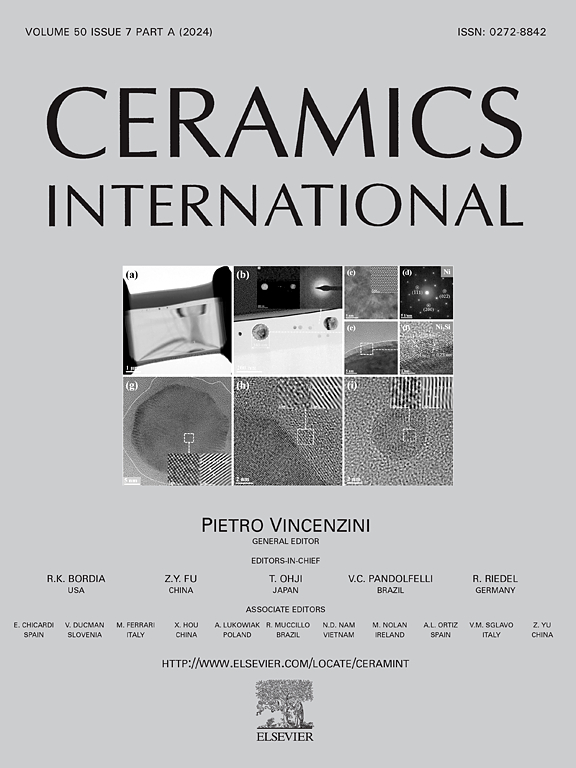Modulating ZnO nanoparticle photoluminescence through Ce³⁺-Induced defect engineering: A study of microstructural and spectroscopic properties
IF 5.6
2区 材料科学
Q1 MATERIALS SCIENCE, CERAMICS
引用次数: 0
Abstract
This work investigates the effect of Cerium ion (Ce³⁺) doping on the light-matter interactions and morphology of chemically synthesized ZnO nanoparticles are studied as a function of Ce³⁺ doping concentration of ( and ). The impact of Ce³⁺ doping on the electronic structure and morphology of chemically co-precipitated ZnO nanoparticles is examined. The optical, morphological, and structural properties of ZnO nanoparticles are modified by Ce³⁺ doping. The lattice parameters of the wurtzite hexagonal ZnO phase, with a secondary CeO₂ phase, were slightly distorted by Ce³⁺ substitution for Zn2⁺ ions. This was confirmed by Rietveld refinement of X-ray diffraction (XRD) data using FullProf software. A comprehensive study was conducted to investigate the morphology, particle size distribution, and shape of the Ce³⁺-doped nanoparticles. TEM and SEM were used to characterize these structural properties. UV–vis spectroscopy showed a red-shift in the bandgap due to Ce³⁺ doping, with bandgap energy (Eg) of 2.81 eV; an absorption edge (Eu) = 1.29 eV. Localized energy states were formed within the band structure, as evidenced by the red-shift. Ce³⁺ doping induced a red-shift in the Zn-O bond vibrational mode, as observed by FTIR spectroscopy. The increased PL emission intensity suggested improved optical properties. Ce³⁺ doping significantly modified the optical properties of the ZnO nanoparticles. This study highlights the potential of Ce³⁺-doped ZnO nanoparticles for optoelectronic applications requiring tunable optical properties. Further investigation into the antibacterial properties of these synthesized NPs is warranted, as they show promise in this area.
通过Ce³+诱导缺陷工程调制ZnO纳米粒子光致发光:微观结构和光谱性质的研究
本文研究了铈离子(Ce +)掺杂对光物质相互作用的影响,并研究了Ce +掺杂Zn1−xCexO浓度(x=0、0.1、0.2和0.3)对化学合成ZnO纳米粒子形貌的影响。研究了Ce³+掺杂对化学共沉淀ZnO纳米粒子电子结构和形貌的影响。Ce +掺杂修饰了ZnO纳米粒子的光学、形态和结构性质。Ce³+取代Zn2 +后,具有次级CeO 2相的纤锌矿六方ZnO相的晶格参数略有扭曲。利用FullProf软件对x射线衍射(XRD)数据进行了Rietveld细化,证实了这一点。我们对Ce³+掺杂纳米颗粒的形貌、粒径分布和形状进行了全面的研究。利用透射电镜和扫描电镜对其结构性能进行表征。紫外可见光谱显示,Ce³+掺杂导致带隙出现红移,带隙能(Eg)为2.81 eV;吸收边(Eu) = 1.29 eV。在能带结构内形成局域能态,红移证明了这一点。Ce³+掺杂引起了Zn-O键振动模式的红移,通过FTIR光谱观察到。PL发射强度的增加表明光学性能的改善。Ce³+掺杂显著改善了ZnO纳米颗粒的光学性质。这项研究强调了Ce +掺杂ZnO纳米颗粒在需要可调光学特性的光电应用中的潜力。进一步研究这些合成的NPs的抗菌性能是必要的,因为它们在这一领域显示出希望。
本文章由计算机程序翻译,如有差异,请以英文原文为准。
求助全文
约1分钟内获得全文
求助全文
来源期刊

Ceramics International
工程技术-材料科学:硅酸盐
CiteScore
9.40
自引率
15.40%
发文量
4558
审稿时长
25 days
期刊介绍:
Ceramics International covers the science of advanced ceramic materials. The journal encourages contributions that demonstrate how an understanding of the basic chemical and physical phenomena may direct materials design and stimulate ideas for new or improved processing techniques, in order to obtain materials with desired structural features and properties.
Ceramics International covers oxide and non-oxide ceramics, functional glasses, glass ceramics, amorphous inorganic non-metallic materials (and their combinations with metal and organic materials), in the form of particulates, dense or porous bodies, thin/thick films and laminated, graded and composite structures. Process related topics such as ceramic-ceramic joints or joining ceramics with dissimilar materials, as well as surface finishing and conditioning are also covered. Besides traditional processing techniques, manufacturing routes of interest include innovative procedures benefiting from externally applied stresses, electromagnetic fields and energetic beams, as well as top-down and self-assembly nanotechnology approaches. In addition, the journal welcomes submissions on bio-inspired and bio-enabled materials designs, experimentally validated multi scale modelling and simulation for materials design, and the use of the most advanced chemical and physical characterization techniques of structure, properties and behaviour.
Technologically relevant low-dimensional systems are a particular focus of Ceramics International. These include 0, 1 and 2-D nanomaterials (also covering CNTs, graphene and related materials, and diamond-like carbons), their nanocomposites, as well as nano-hybrids and hierarchical multifunctional nanostructures that might integrate molecular, biological and electronic components.
 求助内容:
求助内容: 应助结果提醒方式:
应助结果提醒方式:


